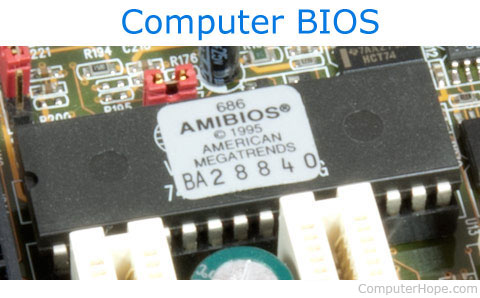What is the difference between BIOS and CMOS?
The terms BIOS and CMOS both refer to essential parts of your computer's motherboard. They work together and they're both important, but they are not the same thing.
Let's take a look at what the BIOS and CMOS are, and how they're different.
BIOS
The BIOS, or "Basic Input/Output System", is special firmware stored in a chip on your computer's motherboard. It is the first program that runs every time you turn on your computer.

The BIOS performs the POST, which initializes and tests your computer's hardware. Then it locates and runs your boot loader, or loads your operating system directly.
The BIOS also provides a simple interface for configuring your computer's hardware. When you start your computer, you may see a message like "Press F2 for setup." This setup is your BIOS configuration interface. For more information about configuring your BIOS, see our guide to configuring your BIOS.
CMOS
When you make changes to your BIOS configuration, the settings are not stored on the BIOS chip itself. Instead, they are stored on a special memory chip, which is referred to as "the CMOS." CMOS stands for "Complementary Metal-Oxide-Semiconductor." It's the name of a manufacturing process used to create processors, RAM, and digital logic circuits, and is also the name for chips created using that process.
Like most RAM chips, the chip that stores your BIOS settings is manufactured using the CMOS process. It holds a small amount of data, usually 256 bytes. The information on the CMOS chip includes what types of disk drives are installed on your computer, the current date and time of your system clock, and your computer's boot sequence.
On some motherboards, the CMOS is a separate chip. However, on most modern motherboards, it is integrated with the real-time clock (RTC) on the southbridge.
Your BIOS memory is non-volatile: it retains its information even when your computer has no power because your computer needs to remember its BIOS settings even when it's turned off. That's why the CMOS has its own dedicated power source, which is the CMOS battery.
CMOS battery
 The CMOS battery is a Lithium-ion battery about the size of a coin. It can hold a charge for up to ten years before needing to be replaced. If your CMOS battery dies, your BIOS settings will reset to their defaults when your computer is turned off.
The CMOS battery is a Lithium-ion battery about the size of a coin. It can hold a charge for up to ten years before needing to be replaced. If your CMOS battery dies, your BIOS settings will reset to their defaults when your computer is turned off.
Tip: If you turn on your computer and notice that your hardware settings have changed, or that your system clock has reset to a date in the past (like January 1st, 1970), there's a good chance that your CMOS battery is dead and needs to be replaced.
Some motherboards, including most modern ATX motherboards, will continue to provide power to the CMOS if the battery is replaced while the computer is powered on.
Warning: If you want to replace your CMOS battery, make sure to consult your motherboard documentation for details and safety information. Visit your motherboard manufacturer's support website if you need to download a new copy of your manual.
Additional information
- How do I configure my BIOS?
- Help with computer BIOS updates.
- How does a computer work?
- BIOS help and support.
- CMOS help and support.
- See our BIOS and CMOS definitions for further information and related links.
Comments
Post a Comment